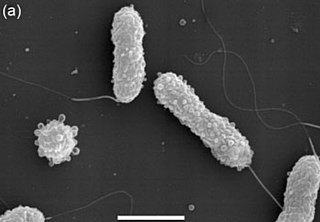
Aerococcus is a genus in the phylum Bacillota (Bacteria). The genus was first identified in 1953 from samples of air and dust as a catalase-negative, gram-positive coccus that grew in small clusters. They were subsequently found in hospital environments and meat-curing brines. It has been difficult to identify as it resembles alpha-hemolytic Streptococcus on blood agar plates and is difficult to identify by biochemical means. Sequencing of 16S rRNA has become the gold standard for identification, but other techniques such as MALDI-TOF have also been useful for identifying both the genus and species.
Herbaspirillum rhizosphaerae is a Gram-negative mesophilic bacterium of the genus Herbaspirillum isolated from rhizosphere soil of Allium victorialis var. platyphyllum on Ulleung Island in Korea.
Collimonas pratensis is a bacterium of the genus Collimonas in the Oxalobacteraceae family which was isolated with Collimonas arenae from seminatural grassland soils in the Netherlands. C. pratensis grows in meadow soils.
Glaciimonas singularis is a rod-shaped, Gram-negative bacterium of the genus Glaciimonas which was isolated from a uranium mine wastewater treatment plant. G. singularis grows optimally at 25 °C. Phylogenetic analysis has shown G. singularis belongs to the Oxalobacteraceae family and is very similar to Glaciimonas immobilis.
Naxibacter alkalitolerans is a chemo-organotrophic, catalase-positive, aerobic, and Gram-negative bacterium, which was isolated from a soil sample collected from Yunnan Province in China. Phylogenetic analyses have shown that it belongs to the Oxalobacteraceae.
Massilia aurea is a Gram-negative, rod-shaped non-spore-forming motile and strictly aerobic bacterium from the genus Massilia and family Oxalobacteraceae. It was isolated from the drinking water distribution system in Seville, Spain. M. aurea produces yellow-pigmented colonies.

Massilia brevitalea is a Gram-negative, strictly aerobic non-spore-forming short rods bacterium from the genus Massilia and family Oxalobacteraceae, which was isolated from lysimeter soil. Colonies of M. brevitalea are pale white to yellow in color.
Massilia niabensis is a Gram-negative, aerobic, motile, rod-shaped bacterium from the genus Massilia and family Oxalobacteraceae, which was isolated with Massilia niastensis from air samples from Suwon in Korea. Colonies of M. niabensis are yellowish white.
Massilia niastensis is a Gram-negative, aerobic, motile, rod -shaped bacterium from the genus Massilia and family Oxalobacteraceae, which was isolated with Massilia niabensis from air samples from Suwon in Korea. Colonies of M. niastensis are ivory-coloured.
Aquabacterium commune is a Gram-negative, catalase-negative bacterium of the genus Aquabacterium in the family Comamonadaceae, which was isolated with Aquabacterium citratiphilum and Aquabacterium parvum from biofilms of drinking water in Berlin. Aquabacterium commune has got a single polar flagellum and its colonies are transparent.
Comamonas composti is an aerobic, Gram-negative, rod-shaped, non-spore-forming, weak oxidase-positive, catalase-positive, motile bacterium from the genus Comamonas and family Comamonadaceae, which was isolated from food waste compost.
Comamonas denitrificans is a Gram-negative, oxidase- and catalase-positive, motile bacterium with a polar flagellum from the genus Comamonas and family Comamonadaceae, which was isolated from an activated sludge. Its colonies are yellow-white colored. Unlike other species of Comamonas, C. denitrificans can reduce nitrate to nitrogen gas.
Comamonas kerstersii is a Gram-negative, oxidase- and catalase-positive, motile bacterium with multitrichous polar flagella from the genus Comamonas and family Comamonadaceae. C. kerstersii is a subgroup of Comamonas terrigena, and has been linked to cases of perforated appendices.
Comamonas nitrativorans is a Gram-negative, oxidase- and catalase-positive bacterium from the genus Comamonas, which was isolated from a denitrifying reactor treating landfill leachate. C. nitrativorans has the ability to perform anoxic-reduction of nitrate, nitrite, and nitrous oxide to nitrogen.
Hydrogenophaga bisanensis is a Gram-negative, non-spore-forming, rod-shaped bacterium from the Comamonadaceae family, which was isolated from wastewater from a textile dye works in Korea. Colonies of H. bisanensis are moderate yellow in color.
Parasutterella secunda is a Gram-negative, nonsaccharolytic, strictly anaerobic, non-spore-forming, nonmotile bacterium of the genus Parasutterella in the family Sutterellaceae, isolated from human faeces. Colonies of Parasutterella secunda are translucent to beige colored.
Paraburkholderia rhizoxinica is a gram-negative, oxidase and catalase-positive, motile bacterium from the genus Paraburkholderia and the family Burkholderiaceae which was isolated from the plant pathogenic fungus, Rhizopus microsporus. The complete genome of Paraburkholderia rhizoxinica is sequenced.
Chitinimonas koreensis is a Gram-negative, catalase- and oxidase-positive motile bacterium with a single flagellum of the genus Chitinimonas and the family Burkholderiaceae which was isolated from greenhouse soil in Korea.
Cupriavidus respiraculi is a Gram-negative, nonfermenting bacterium of the genus Cupriavidus and family Burkholderiaceae. It has been isolated from cystic fibrosis patients.
Marichromatium is a genus in the phylum Pseudomonadota (Bacteria). The name Marichromatium derives from: Latin mare, the sea; Neo-Latin Chromatium, a genus name; to give Marichromatium, the Chromatium of the sea, the truly marine Chromatium.


